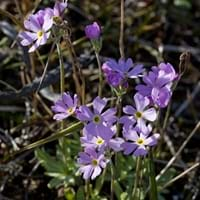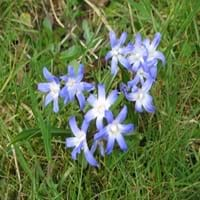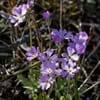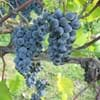Life Span
Perennial
Perennial
Type
Perennial
Bulb or Corm or Tuber
Origin
Northeastern United States, Mid-Atlantic United States, Southeastern United States, North-Central United States, Central United States, South-Central United States
Mediterranean, Turkey
Types
Not Available
Not Available
Habitat
Roadsides, sand dunes, Waste areas
meadows, Terrestrial
USDA Hardiness Zone
5-8
3-9
Sunset Zone
1a, 1b, 2a, 2b, 3a, 3b, 4, 5, 6, 7, 8, 9, 10, 11, 12, 13, 14, 15, 16, 17, 18, 19, 20, 21, 22, 23, 24
21,22
Habit
Clump-Forming
Clump-Forming
Flower Color
White, Ivory
White, Blue, Pink, Violet
Flower Color Modifier
Bicolor
Bicolor
Fruit Color
Tan
Not Available
Leaf Color in Spring
Green
Green
Leaf Color in Summer
Green
Light Green
Leaf Color in Fall
Green
Several shades of Green
Leaf Color in Winter
Light Green
Light Green
Leaf Shape
Oblong
Long Linear
Plant Season
Summer
Spring, Winter
Sunlight
Full Sun, Partial Sun
Full Sun, Partial Sun
Growth Rate
Medium
Medium
Type of Soil
Loam, Sand
Loam
The pH of Soil
Acidic, Neutral, Alkaline
Acidic, Neutral, Alkaline
Soil Drainage
Well drained
Well drained
Bloom Time
Early Summer, Summer, Late Summer
Early Spring, Late Winter
Tolerances
Variety of soil types
Drought
Where to Plant?
Container, Ground, Pot
Container, Ground, Pot
How to Plant?
Divison, Seedlings, Stem Planting
From bulbs, Seedlings
Plant Maintenance
Low
Medium
Watering Requirements
Average Water Needs, Do Not over Water, Never Over-water, Requires regular watering, Water more in summer
Average Water Needs, Do Not over Water, Do not water frequently, Keep the ground moist but not water-logged, Never Over-water
In Summer
Lots of watering
Lots of watering
In Spring
Moderate
Moderate
In Winter
Average Water
Average Water
Soil pH
Acidic, Neutral, Alkaline
Acidic, Neutral, Alkaline
Soil Type
Loam, Sand
Loam
Soil Drainage Capacity
Well drained
Well drained
Sun Exposure
Full Sun, Partial Sun
Full Sun, Partial Sun
Pruning
Remove damaged leaves, Remove dead branches, Remove dead leaves, Remove dead or diseased plant parts
Remove damaged leaves, Remove dead branches, Remove dead leaves
Fertilizers
All-Purpose Liquid Fertilizer, fertilize in growing season
All-Purpose Liquid Fertilizer
Pests and Diseases
Slugs, Snails
Red blotch
Plant Tolerance
Variety of soil types
Drought
Flower Petal Number
Single
Single
Foliage Texture
Fine
Fine
Foliage Sheen
Matte
Matte
Attracts
Insects
Bees, Flying insects
Allergy
Abdominal pain, Constipation, Diarrhea, Skin irritation
Skin rash
Aesthetic Uses
Beautification, Borders, Landscape Designing, Showy Purposes
Beautification, Bouquets, Ground Cover, Showy Purposes
Beauty Benefits
Good for skin, Making cosmetics, Stops hair loss
Not Available
Environmental Uses
Air purification, Food for insects, Versatility
Air purification
Medicinal Uses
Eczema
No Medicinal Use
Part of Plant Used
Root
Flowers
Other Uses
Decoration Purposes, Medicinal oil, Showy Purposes, Used as Ornamental plant, Used for its medicinal properties
Decoration Purposes, Showy Purposes, Used as Ornamental plant
Used As Indoor Plant
Yes
Yes
Used As Outdoor Plant
Yes
Yes
Garden Design
Edging, Feature Plant, Groundcover, Mixed Border
Alpine, Container, Foundation, Lawns and Turf, Mixed Border, Rock Garden / Wall, Wildflower
Botanical Name
Primula mistassinica
CHIONODOXA
Common Name
Mistassini primrose, Lake Mistassini primrose, bird's-eye primrose
Chionodoxa, Glory-of-the-Snow
In Hindi
Mistassini Primrose
Chionodoxa
In German
Mistassini Primrose
Chionodoxa
In French
Primrose Mistassini
Chionodoxa
In Spanish
Mistassini Primrose
Chionodoxa
In Greek
Mistassini Primrose
Chionodoxa
In Portuguese
Mistassini Primrose
Chionodoxa
In Polish
Mistassini Primrose
Chionodoxa
In Latin
Mistassini Primrose
Chionodoxa
Phylum
Magnoliophyta
Platyhelminthes
Class
Magnoliopsida
Cestoda
Family
Onagraceae
Liliaceae
Genus
Oenothera
Chionodoxa
Clade
Angiosperms, Eudicots, Rosids
Angiosperms, Monocots
Tribe
Onagreae
Not Available
Subfamily
Onagroideae
Not Available
Season and Care of Mistassini Primrose and Chionodoxa
Season and care of Mistassini Primrose and Chionodoxa is important to know. While considering everything about Mistassini Primrose and Chionodoxa Care, growing season is an essential factor. Mistassini Primrose season is Summer and Chionodoxa season is Summer. The type of soil for Mistassini Primrose is Loam, Sand and for Chionodoxa is Loam while the PH of soil for Mistassini Primrose is Acidic, Neutral, Alkaline and for Chionodoxa is Acidic, Neutral, Alkaline.
Mistassini Primrose and Chionodoxa Physical Information
Mistassini Primrose and Chionodoxa physical information is very important for comparison. Mistassini Primrose height is 610.00 cm and width 460.00 cm whereas Chionodoxa height is 10.20 cm and width 5.10 cm. The color specification of Mistassini Primrose and Chionodoxa are as follows:
Mistassini Primrose flower color: White and Ivory
Mistassini Primrose leaf color: Green
Chionodoxa flower color: White, Blue, Pink and Violet
- Chionodoxa leaf color: Green
Care of Mistassini Primrose and Chionodoxa
Care of Mistassini Primrose and Chionodoxa include pruning, fertilizers, watering etc. Mistassini Primrose pruning is done Remove damaged leaves, Remove dead branches, Remove dead leaves and Remove dead or diseased plant parts and Chionodoxa pruning is done Remove damaged leaves, Remove dead branches and Remove dead leaves. In summer Mistassini Primrose needs Lots of watering and in winter, it needs Average Water. Whereas, in summer Chionodoxa needs Lots of watering and in winter, it needs Average Water.





